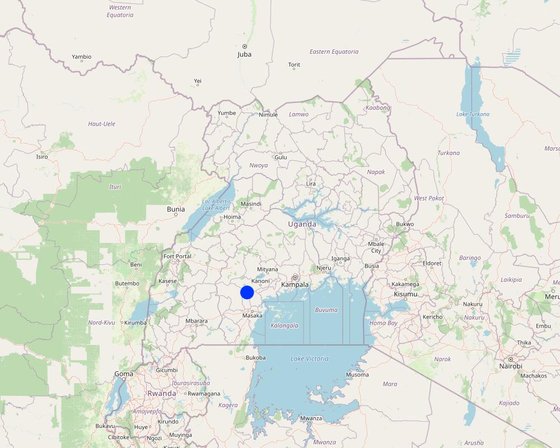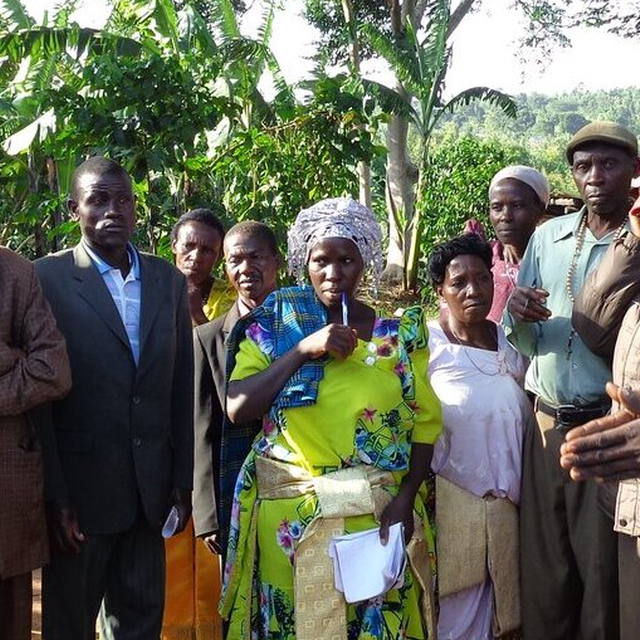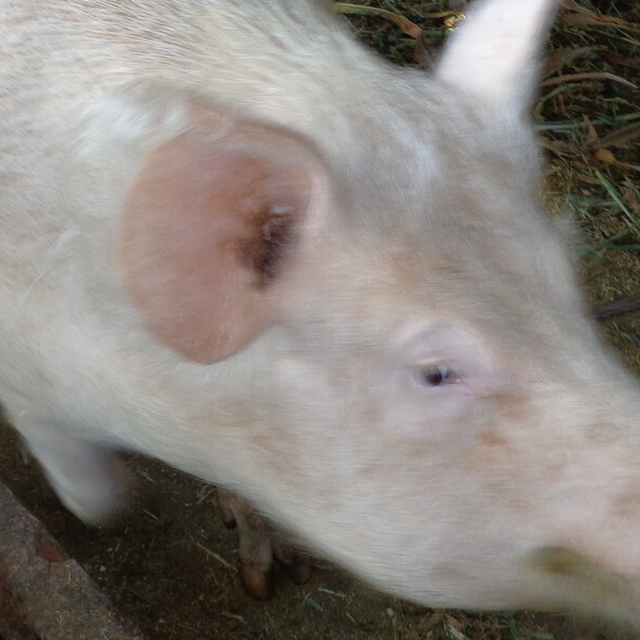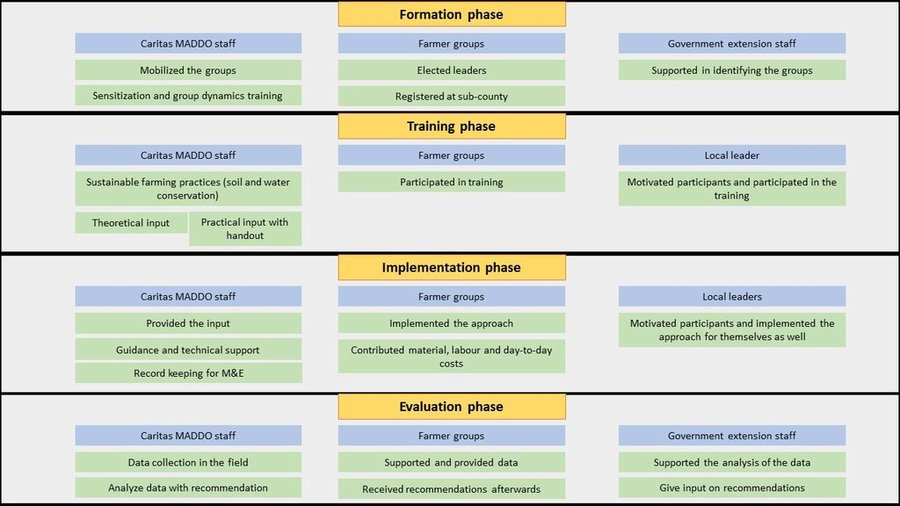MADDO SLM approach
(Uganda)
obugimu bwettaka ngokozesa obusa bwembizzi mu mwannyi ne bitooke
Description
This integrated soil fertility management approach aims at identifying and promoting practices in land management that can increase soil fertility, reduce land degradation and improve production. Under this specific example, organic manure from a piggery was applied to banana and coffee plantations.
The main objective of the MADDO approach is to test and promote, in a pilot area, the advantages for small-scale farmers of organic manure from piggeries in coffee and banana plantations. The approach aims not only to increase farmers' production through multiple income streams from the integrated production systems but also to secure those income streams by enhancing soil fertility and decreasing land degradation for long-term sustainability. One distinct feature of the approach is the emphasis on cost-effective technologies for small-scale farmers. In the case of the piggery-banana-coffee enterprise, the investment capital needed is very low and the technology is not complicated.
The focus was on small-scale farmer groups of 30-35 members (roughly 200 farmers in 6 groups participated) and was coordinated by Caritas MADDO (one project coordinator and three field staff officers) and agriculture officers from the subcounty level. Groups were identified and implementation concentrated on various trainings for farmers on piggery management, banana and coffee production. In particular, the production of organic manure was highlighted in training, with emphasis on collection, storage and application. After basic training, farmers are led through the one-year production cycle which includes the following stages: rearing of the pigs; manure collection; storage in a pit for decomposition (one to two months); application of the manure during the rainy season when the plants are healthy and actively growing; and then ongoing monitoring, and if needed repetition of the stages and reapplication of the manure (two times per year).
The small-scale farmers appreciate the technology because of the higher production and income they are gaining. It is easy and cheap - particularly because the enterprise can be spread by beneficiary farmers passing on piglets to new farmers. Nevertheless, there is the possibility of the pigs catching diseases (African swine fever) and once infected the farmers have no options for relief as an entire piggery can be wiped out. Moreover, farmers have complained that water scarcity and unsuitable weather conditions can affect production.
Location

Location: Lutugunda village in Bukomansimbi district, Central Region, Uganda
Geo-reference of selected sites
Initiation date: n.a.
Year of termination: n.a.
Type of Approach
-
traditional/ indigenous
-
recent local initiative/ innovative
-
project/ programme based

Participants during training (Mulindwa Michael)

Pig of the participants in new established piggery (Mulindwa Michael)
Approach aims and enabling environment
Main aims / objectives of the approach
The main objective of the approach from an organizational perspective was to test in a pilot area the advantages of organic manure from piggery in a coffee and banana plantation. The approach aims not only to increase farmers' production through multiple income streams from piggery, banana and coffee but also to secure those income streams by enhancing the soil fertility and decreasing land degradation for long-term sustainability.
Conditions enabling the implementation of the Technology/ ies applied under the Approach
-
Social/ cultural/ religious norms and values: Piggeries are common among the groups
-
Availability/ access to financial resources and services: Input supply was provided
-
Institutional setting: With the presence of the extension officers from the government and other NGOs in the area
-
Collaboration/ coordination of actors: Collaboration was part of the overall project design
-
Legal framework (land tenure, land and water use rights): only customary rights practices, but no conflicts
-
Markets (to purchase inputs, sell products) and prices: In particular piggery has a high market in the area
Conditions hindering the implementation of the Technology/ ies applied under the Approach
Participation and roles of stakeholders involved
Stakeholders involved in the Approach and their roles
| What stakeholders / implementing bodies were involved in the Approach? |
Specify stakeholders |
Describe roles of stakeholders |
| local land users/ local communities |
Stakeholders centered around the small-scale farmers (one group of 30-35 members) |
|
| community-based organizations |
Caritas MADDO |
|
| SLM specialists/ agricultural advisers |
Agriculture extension officers from subcounty |
|
| NGO |
Caritas MADDO |
|
| local government |
|
|
Involvement of local land users/ local communities in the different phases of the Approach
none
passive
external support
interactive
self-mobilization
initiation/ motivation
The project team involved the community leaders and farmers from prior project phases as well as governmental extension officers have been involved in the initiation of the approach. Activities encompasses the joint group formation and mobilization of fellow farmers to discuss the training needs and capacities.
planning
The above people then continued with jointly discuss the modus operantes with creating a training schedule and actively participating in the learning journey.
implementation
The implementation mainly encompasses the adoption of the SLM technology, and the farmers were the main implementors and actors with offering pilot land and labor. The project contributed advisory support, monitoring and financial support.
monitoring/ evaluation
M&E was done by the project staff, extension officers and the farmers together with the community leaders themselves on a regular basis.

Author: Kyambadde, Tonny
Decision-making on the selection of SLM Technology
Decisions were taken by
-
land users alone (self-initiative)
-
mainly land users, supported by SLM specialists
-
all relevant actors, as part of a participatory approach
-
mainly SLM specialists, following consultation with land users
-
SLM specialists alone
-
politicians/ leaders
Decisions were made based on
-
evaluation of well-documented SLM knowledge (evidence-based decision-making)
-
research findings
-
personal experience and opinions (undocumented)
Technical support, capacity building, and knowledge management
The following activities or services have been part of the approach
-
Capacity building/ training
-
Advisory service
-
Institution strengthening (organizational development)
-
Monitoring and evaluation
-
Research
Capacity building/ training
Training was provided to the following stakeholders
-
land users
-
field staff/ advisers
Form of training
-
on-the-job
-
farmer-to-farmer
-
demonstration areas
-
public meetings
-
courses
Subjects covered
Land and soil management
Sustainable agricultural practices
Piggery management
Advisory service
Advisory service was provided
-
on land users' fields
-
at permanent centres
Institution strengthening
Institutions have been strengthened / established
-
no
-
yes, a little
-
yes, moderately
-
yes, greatly
Describe institution, roles and responsibilities, members, etc.
Type of support
-
financial
-
capacity building/ training
-
equipment
Further details
Input support
Monitoring and evaluation
Research
Research treated the following topics
-
sociology
-
economics / marketing
-
ecology
-
technology
Project staff was during minor research on soil improvement and in particular on fitting livestock integrations. Due to this research pigs were chosen as preferred livestock.
Financing and external material support
Annual budget in USD for the SLM component
-
< 2,000
-
2,000-10,000
-
10,000-100,000
-
100,000-1,000,000
-
> 1,000,000
Precise annual budget: 50000.0
The budget includes staff salary, transport, training costs and inputs for the farmers. In total the approach reached around 200 farmers within six groups in Bukomansimbi (30-35 participants each).
The following services or incentives have been provided to land users
-
Financial/ material support provided to land users
-
Subsidies for specific inputs
-
Credit
-
Other incentives or instruments
Financial/ material support provided to land users
Land users were given input support (coffee seedlings, banana suckers, pigs)
Impact analysis and concluding statements
Impacts of the Approach
No
Yes, little
Yes, moderately
Yes, greatly
Did the Approach empower local land users, improve stakeholder participation?
Technical knowledge of improved management was testified by local land users and group cohesion was strengthened through community labor pooling.
Main motivation of land users to implement SLM
-
increased production
-
increased profit(ability), improved cost-benefit-ratio
-
reduced land degradation
-
reduced risk of disasters
-
reduced workload
-
payments/ subsidies
-
rules and regulations (fines)/ enforcement
-
prestige, social pressure/ social cohesion
-
affiliation to movement/ project/ group/ networks
-
environmental consciousness
-
customs and beliefs, morals
-
enhanced SLM knowledge and skills
-
aesthetic improvement
-
conflict mitigation
Sustainability of Approach activities
Can the land users sustain what hat been implemented through the Approach (without external support)?
With the pass on mechanisms of the pigs and the capacity building through the extension officers. The pass on mechanisms works similar to the Heifer pass on, where participating farmers have to contribute their newborn piglets to other members within the group that have not benefited from the prior project input.
Conclusions and lessons learnt
Strengths: land user's view
-
The pilot small-scale farmers appreciate the approach because of the higher production and income there are gaining. The approach is easy and cheap to be implemented and in particular because a pass-on mechanisms of the pigs were applied.
Strengths: compiler’s or other key resource person’s view
-
Advantages was in the participatory approach, and it was an interactive learning experience
Weaknesses/ disadvantages/ risks: land user's viewhow to overcome
-
The approach is unfortunately affected by the possibility of the pigs catching diseases (African swine fever) and once infected the farmers have no options for relief as entire piggery will be wiped out.
Hygiene training was given and practiced
-
Moreover, farmers have complained that water scarcity and unsuitable weather conditions have affected the approach.
Farmers mobilized for underground water tanks
Weaknesses/ disadvantages/ risks: compiler’s or other key resource person’s viewhow to overcome
-
For the compilers it was difficult to access some of the Information from farmers (e.g., basic records on feeding or construction)
Training was given and also information was collected together with farmers (e.g. calculation made together on construction costs)
References
Editors
-
Beatrice Nabukenya
-
Michael Mulindwa
-
Kyagaba Prossy
-
Annika Reimann
Reviewer
-
William Critchley
-
Rima Mekdaschi Studer
Date of documentation: Aug. 3, 2022
Last update: Nov. 16, 2023
Resource persons
-
Beatrice Nabukenya (bittsbeat@gmail.com) - co-compiler
Full description in the WOCAT database
Documentation was faciliated by
Institution
- Caritas Masaka Diocesan Development Organisation (Caritas MADDO) - Uganda
Project
- Euregio-East Africa Livelihood Improvement Programme (EEALIP)
Links to relevant information which is available online







